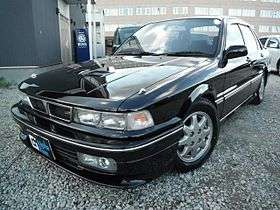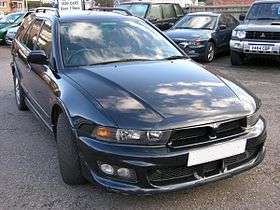Mitsubishi Galant VR-4

The Mitsubishi Galant VR-4 was the range-topping version of Mitsubishi Motors' Galant model, available in the sixth (1988–92), seventh (1992–96) and eighth (1996–2002) generations of the vehicle. Originally introduced to comply with the new Group A regulations of the World Rally Championship, it was soon superseded as Mitsubishi's competition vehicle by the Lancer Evolution, and subsequently developed into a high-performance showcase of the company's technology.
Background and competition history
Throughout the 1970s and 1980s, Mitsubishi Motors Corporation (MMC) sought to improve its image through the established path of participation in motorsport. The Lancer 1600 GSR and Pajero/Montero/Shogun both achieved great success in rallying and Rally Raid events,[1][2] and eventually the company planned an attempt on the Group B class of the World Rally Championship with a four-wheel drive version of its Starion coupé. However, the class was outlawed following several fatal accidents in 1985 and '86, and Mitsubishi was forced to reassess its approach. It instead homologated the recently introduced sixth generation of its Galant sedan for the Group A class, using the mechanical underpinnings from its aborted Starion prototype. Between 1988 and '92, it was campaigned by the official factory outfit, Mitsubishi Ralliart Europe, winning three events in the hands of Mikael Ericsson (1989 1000 Lakes Rally),[3] Pentti Airikkala (1989 Lombard RAC Rally)[4] and Kenneth Eriksson (1991 Swedish Rally).[5] It was also driven to outright victory in the Asia-Pacific Rally Championships by Kenjiro Shinozuka (1988) and Ross Dunkerton (1991–92), and the American National GT Championship (1992) by Tim O'Neil.[6]
However, Mitsubishi — and their competitors — realised that the WRC cars of the '80s were simply too big and ungainly for the tight, winding roads of rally stages. Sometime around 1992, Ford migrated the Sierra/Sapphire Cosworth to a smaller Escort-based bodyshell; Subaru developed the Impreza to succeed their Legacy; Toyota eventually replaced the Celica coupe with the Corolla; and Korea's Hyundai migrated their front-wheel drive Coupe-based rally car to a smaller 3-door Accent hatchback-based bodyshell in 1999. Mitsubishi, meanwhile, carried the VR-4's engine/transmission over to the new Lancer Evolution, bringing to an end the Galant's representation in MMC's motorsport efforts.
WRC Victories
No. Event Season Driver Co-driver 1  39th 1000 Lakes Rally
39th 1000 Lakes Rally1989  Mikael Ericsson
Mikael Ericsson Claes Billstam
Claes Billstam2  38th Lombard RAC Rally
38th Lombard RAC Rally1989  Pentti Airikkala
Pentti Airikkala Ronan McNamee
Ronan McNamee3  22ème Rallye Côte d'Ivoire Bandama
22ème Rallye Côte d'Ivoire Bandama1990  Patrick Tauziac
Patrick Tauziac Claude Papin
Claude Papin4  40th International Swedish Rally
40th International Swedish Rally1991  Kenneth Eriksson
Kenneth Eriksson Staffan Parmander
Staffan Parmander5  23ème Rallye Côte d'Ivoire Bandama
23ème Rallye Côte d'Ivoire Bandama1991  Kenjiro Shinozuka
Kenjiro Shinozuka John Meadows
John Meadows6  24ème Rallye Côte d'Ivoire Bandama
24ème Rallye Côte d'Ivoire Bandama1992  Kenjiro Shinozuka
Kenjiro Shinozuka John Meadows
John Meadows
Sixth generation (E38A/E39A)
| 6th generation | |
|---|---|
 | |
| Overview | |
| Production | 1987–1992 |
| Assembly | Nagoya Plant, Okazaki, Aichi |
| Body and chassis | |
| Body style |
4-door saloon 5-door hatchback |
| Layout | Front engine, four-wheel drive |
| Powertrain | |
| Engine | 1997 cc DOHC 16v I4, turbo |
| Transmission |
Four-wheel drive, 4-speed automatic 5-speed manual |
Group A regulations dictated a turbocharged engine of 2.0 L displacement and a four-wheel drive transmission. In order to satisfy the mandatory minimum sales requirements of 5,000 units, Mitsubishi made it available in North America, New Zealand, Australia, Japan, and other Asian Pacific Rim territories, with 2,000 reaching the United States in 1991, and 1000 units imported in 1992.[7] It also satisfied Japanese regulations concerning external dimensions and engine displacement, thereby reducing a sales handicap in Japan with regards to additional taxes paid by Japanese owners. In road-going trim the four-door sedan produced up to 195 horsepower depending on market, giving the car a top speed of over 130 mph (210 km/h) and allowing it to accelerate from 0-60 in 7.3 seconds, with a quarter mile elapsed time of 15.3 seconds. This car also featured power-assisted speed-sensitive four-wheel steering: the rear wheels steered in the same phase as the front wheels above 30 mph (48 km/h), up to 1.5 degrees.
A liftback version was also produced, known as the Eterna ZR-4. This had some minor cosmetic differences, but mechanically was the same as the VR-4 sedan.
Mitsubishi developed its first high performance four-wheel drive vehicle in 1987, when it equipped the Galant VR-4 with "Dynamic Four" (Mitsubishi AWC), which featured a center differential-type full-time four-wheel drive system (this system incorporated a viscous coupling unit), a four wheel steering system, four-wheel independent suspension, and a four-wheel ABS (the first total integration of these systems in the world that were highly advanced at the time). The 1987 Galant also featured "Dynamic ECS", a world’s first production semi-active electronically controlled suspension system (a means of actively controlling a vehicle’s cornering attitude (body roll) and dynamic performance) that Mitsubishi developed. Mitsubishi's active ECS enhanced ride comfort and kept body inclination to a minimum under all driving conditions by controlling the grip between the tires and the road surface.
Technical specifications
- Engine
- Transmission — 4-speed auto / 5-speed manual
- Suspension — MacPherson struts (front), multi-link (rear)
- Dimensions
- Length — 4,560 mm (179.5 in)
- Width — 1,695 mm (66.7 in)
- Height — 1,440 mm (56.7 in)
- Wheelbase — 2,600 mm (102.4 in)
- Kerb weight — 1,483 kg (3,269 lb)
- Fuel tank — 62 L
- Wheels/tyres — 195/60 R15 86H
Seventh generation (E84A/E74A)
Eighth generation (EC5A/EC5W)
| 8th generation | |
|---|---|
 | |
| Overview | |
| Production | 1996–2003 |
| Assembly | Nagoya Plant, Okazaki, Aichi |
| Body and chassis | |
| Body style |
4-door saloon 5-door wagon |
| Layout | Front engine, four-wheel drive |
| Powertrain | |
| Engine | 2498 cc DOHC 24v V6, twin-turbo |
| Transmission |
Four-wheel drive, 5-speed semi-auto 5-speed manual |
The final VR-4 was introduced in 1996. The engine capacity was enlarged substantially to 2.5 L, which pushed the power up by 15 percent to the Japanese voluntary limit of 206 kW (280 PS; 276 hp), but no longer satisfied Japanese regulations concerning engine displacement size and, as a result, Japanese buyers were now liable for additional yearly tax requirements. The car was now capable of over 150 mph (240 km/h) when derestricted, and could accelerate from 0-60 mph (0–96 km/h) in 5.7 seconds for the INVECS-II and 5.4 for the manual.[8][9]
The Type-V model could be specified with either the existing 5-speed manual or the optional INVECS-II, which was now an advanced self-learning 5-speed semi-auto based on Porsche's Tiptronic transmission, while the Type-S model offered the optional Active Yaw Control (AYC). This complex rear diff was first seen on the Lancer Evo IV, and used an array of sensors to detect and quell oversteer, giving the ultimate VR-4 great agility for a vehicle of its size and weight. A Super VR-4 variant was sold on both the Galant sedan and the Legnum wagon, with only cosmetic changes such as Recaro front seats and Momo steering wheel.
With the eighth generation of the Galant, Mitsubishi introduced a station wagon (known in many markets as the Legnum) to replace the old 5-door hatchback, and the VR-4 was now available in both body styles.
North America and Europe were again denied this model, but the burgeoning grey import trade meant that it developed a cult following in several overseas territories, especially the United Kingdom and New Zealand. In 2000 MMC's motorsport partner Ralliart was contracted to type-approve Galants and Lancers for UK sales, and 200 VR-4s were officially imported before production finally ceased two years later.
Technical specifications
- Engine
- Configuration — DOHC 24v V type 6-cylinder
- Code — 6A13TT
- Bore/stroke, capacity — 81.0 × 80.8 mm, 2498 cc
- Compression ratio — 8.5:1
- Fuelling — ECI-MULTI, premium unleaded fuel
- Peak power — 206 kW (280 PS; 276 hp) at 5500 rpm
- Peak torque — 367 N·m (271 lb·ft) at 4000 rpm
- Transmission — 5-speed semi-auto / 5-speed manual
- Suspension — Multi-link (front & rear)
- Dimensions
- Length — 4,680 mm (184.3 in)
- Width — 1,760 mm (69.3 in)
- Height — 1,420 mm (55.9 in)
- Wheelbase — 2,635 mm (103.7 in)
- Curb weight — 1,520 kg (3,350 lb)
- Fuel tank — 60 L
- Wheels/tyres — 205/55 R16 91V

References
- ↑ Lancer 1600GSR, Mitsubishi Motors' Web Museum
- ↑ "Pajero - King of the Desert", Mitsubishi Motors' Web Museum
- ↑ 39th 1000 Lakes Rally, Final classification, Rallybase.nl website
- ↑ 38th Lombard RAC Rally, Final classification, Rallybase.nl website
- ↑ 40th International Swedish Rally, Final classification, Rallybase.nl website
- ↑ Biography of Tim O'Neil, Rally Racing News
- ↑ Mitsubishi Galant VR-4s imported into the United States (6th generation), GalantVR4.org website
- ↑ "2000 Mitsubishi Galant VR-4 Type-S". Automobile Catalog. Retrieved 2015-12-02.
- ↑ "2001 Mitsubishi Galant VR-4 Type-V". Automobile Catalog. Retrieved 2015-12-02.
External links
- Galant 1988–1990 VR-4 at Mitsubishi Motors Web Museum
- Galant 1991–1992 VR-4 at Mitsubishi Motors Web Museum
- Technical specifications
- technical Details and Informations about Legnum VR4 & Galant VR4
| Wikimedia Commons has media related to Mitsubishi Galant VR-4. |